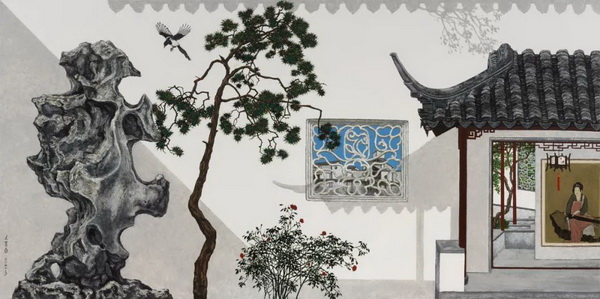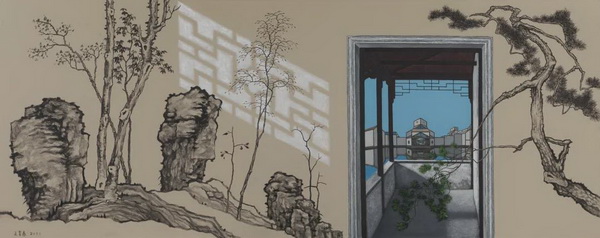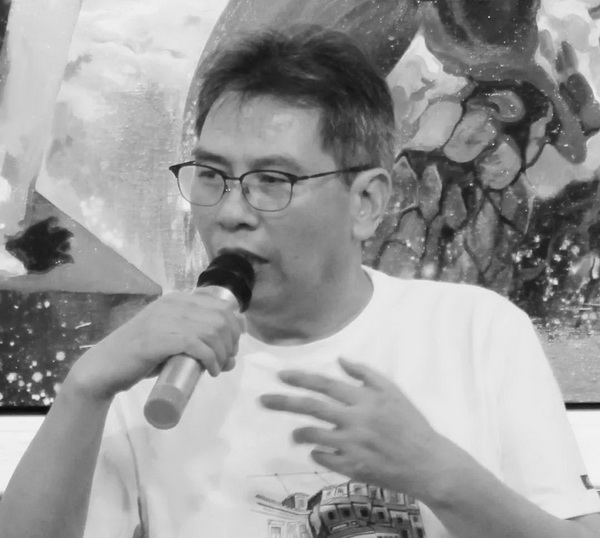“温和的反叛——王育桑之江南”北京开展

展览名称: 温和的反叛——王育桑之江南
策展人: 荣剑
学术主持: 王端廷
参展艺术家: 王育桑
主办: 北京锦都艺术中心展览
时间 : 2021年05月12日至 6月11日(周二至周日10:00 – 17:00)
开幕活动: 2021年5月16日(周日),15:00 至 17:30
地点 : 北京市朝阳区酒仙桥北路9号恒通国际创新园C9号楼蓝色光标公司北门锦都艺术中心展厅
Exhibition: The Moderate Rebellion –——Wang Yusang’s Southern China
Curator :Rong Jian
Academic Host: Wang Duanting
Artist: Wang Yusang
Host: Beijing Jindu Art Centre
Duration: 2021.05.12 – 06.11 (10:00 – 17:00, Tuesday – Sunday)
Opening Ceremony: 15:00 – 17:30, 2021.05.16 (Sunday)
Venue: Exhibition Hall of Beijing Jindu Art Centre, North Entrance of BlueFocus Co Ltd,Building C9, Universal Creative Park, No 9 Jiuxianqiao North Road, Chaoyang District, Beijing
温和的反叛——王育桑的“后观念主义”新作解读
王端廷
面对王育桑的绘画新作,入目之顷,我们会被画面的古典气息所吸引,但稍加凝视,我们又会被作品中有某种陌生的东西所疑惑。这种既熟悉又陌生的感觉究竟因何产生?抑或说,这些作品中究竟隐藏着什么秘密?

竹石图 Bamboo and Stone,布面油画 Oil on Canvas,2020,80×120cm
王育桑这批以苏州园林为题材的作品看似来自对景写生亦即写实的产物,因为画面上有房屋、围墙、月亮门、太湖石、树木和花草等苏州古典园林的真实景物,然而,在作品中的许多局部却呈现的是非现实的形象,熟知美术史的观众知道,那些形象大多是来自中国古代绘画中的图像。例如:《祥龙听琴图》(2019年)中的太湖石、树枝、古琴、方桌、香几和香炉分别取自宋徽宗赵佶的《祥龙石图》和《听琴图》中的图像,《桃鸠春园图》(2020年)中的花鸟是赵佶的《桃鸠图》的翻版,而《竹石图》(2020年)中的墨竹则是对宋代文同作品的复制。除此之外,在王育桑该系列作品中还有一些来自现代摄影作品的形象,例如那只在许多作品中反复出现的飞翔的喜鹊。实际上,王育桑的苏州园林系列绘画是在客观再现幌子下的主观再造,更确切地说,这类作品更多地是来自对现成图像的复制、挪用和重构。这是一种观念主义的创作方式,但它与杜尚最初创立的观念艺术的性质大有不同,甚至完全相反,因此,我们可以将其称为“后观念主义”。

易景江南 Gardens with Assorted Scenes in Southern China,2020,布面油画 Oil on Canvas,100×200cm
我们知道,达达主义的创始人杜尚在1913年利用现成品创立观念主义的初衷是反审美、反传统和反艺术,换一句话,观念主义被发明的目的是反叛既定的艺术标准,其功能是批判性。今天人们普遍接受的观念主义艺术的基本属性是批判而非审美的说法也由此产生。然而,西方艺术的发展始终遵循着“否定之否定”规律,当20世纪50年代新达达主义(也就是波普艺术)兴起时,观念主义由反艺术变成了新的艺术,并且具有了形式美的价值。到了当代艺术时期,观念主义作为一种成熟而流行的艺术样式被艺术家们注入了越来越丰富、越来越深刻的内涵。此时,观念主义已经拥有了过往艺术的所有功能,不仅可以叙事,甚至可以抒情,这就是“后观念主义”的特征。

日照翠松图 Green Pine Trees on Sunny Day,2021,布面油彩丙烯 Oil and Acrylic on Canvas,80×200cm
王育桑的苏州园林系列作品巧妙地将实景与现成图像拼接在一起,几乎达到了虚实难辨、天衣无缝的效果。仔细分析,我们可以看出他利用了园林建筑的特性将各种非现实图像嫁接到现实空间中,让画面呈现出一种戏剧舞台般的景象。门窗几乎出现在他的苏州园林系列所有作品中,但这些门窗中往往展现的是来自古代绘画和现代摄影中的非现实图像;实际上,门窗在这里不仅起到了丰富作品内涵的“画中画”的作用,而且起到了既连接又分割真实和虚幻世界的功效。虽然有墙壁和门窗,而且墙壁上还有漏窗的阴影,但我们却难以断定这些作品描绘的是室内景还是室外景。应该说,王育桑给我们呈现的是一个超越自然的纯绘画空间,苏州园林仅仅给了他编排这个观念化的空间或画面的引子,他用智慧的画笔塑造出一种心灵的图像。

如歌如翔 Flying and Singing,布面油画 Oil on Canvas,2017,80×160cm
王育桑的新作采用的是油画的材料和语言,画面有焦点透视,有明暗光影,还有肌理质感,但作品却洋溢着浓烈的中国传统绘画的气息。毫无疑问,王育桑既对中国传统艺术抱有强烈的迷恋之情,又对世界当代艺术观念持有认同立场。他以一种温和的反叛态度创造了一种既古典又新颖的绘画,为中国艺术的发展和创新进行了有益的探索。
二O二O年九月

祥龙听琴图 Auspicious Dragon Rock and Guqin,2019,布面油画 Oil on Canvas,80×160
The Moderate Rebellion
An Analysis on the Paintings of Post-Conceptualism by Wang Yusang
By Wang Duanting
September 2020
Taking the first look at the oil paintings newly created by Wang Yusang, we are mostly attracted by the Chinese ancient classical breath in his artworks; and shortly after that, however, we would feel puzzled by some unfamiliarity presented in the paintings. How come we have such experience of both familiarity and unfamiliarity? Or what secrets are hidden in the artworks?
The ancient gardens in Suzhou are the main theme of these paintings by Wang Yusang. As such real objects in the Suzhou gardens as buildings, walls, moon-shaped gates, Taihu stones, trees, flowers and plants are depicted in the paintings, it looks like these artworks are based on scenery sketching in the Suzhou gardens, or are realistic depictions of the gardens. However, many parts of the paintings are presented as unrealistic images. Viewers who have good knowledge of the art history are clear that most of these images are from Chinese ancient paintings. For example, the images of Taihu rock, plant, guqin, square table, incense table and incense burner in Auspicious Dragon Rock and Guqin (2019) are taken from the Chinese ancient paintings Auspicious Dragon Rock and Listening to Guqin, both of which are created by Emperor Zhao Ji of the Song Dynasty. And the bird and plant in Peach Blossoms and Turtledove in Spring Garden (2020) are reproductions of the bird and plant in Emperor Zhao Ji’s painting named Peach Blossom and Turtledove; while the ink bamboo in Wang Yusang’s Bamboo and Stone (2020) is reproduced from the artwork by Wen Tong, a well-known artist in the Song Dynasty. Further to using images from Chinese ancient paintings in his artworks, Wang Yusang has also created some images based on contemporary photos, for instance, the magpie which appears in many of his paintings. In fact, the series of Suzhou garden paintings by Wang Yusang is subjective creation under the guise of objective depiction. More precisely, these artworks are to a large extent created from duplicating, diverting and restructuring of ready-made images. This way of art creation is known as the method of Conceptualism, but it is in nature substantially different from the conceptual art initiated by Marcel Duchamp (1887- 1968), or even completely the opposite. As such, this way of art creation is labeled as Post-Conceptualism.
We know that when Marcel Duchamp used ready-made products to invent Conceptualism in 1913, his original intention is of anti-aesthetics, anti-tradition and anti-art. In other words, Conceptualism was formulated to rebel against established artistic standards, and its function is critical, which resulted in the widely accepted knowledge today that the basic character of Conceptualism is critical rather than aesthetic. The development of western art constantly follows the law of negation of negation. When the Neo-Dadaism (namely the Pop Art) started to prevail in the 1950’s, Conceptualism changed to a new art from anti-art, and even gained value in formal aesthetics. In the time of contemporary art, Conceptualism as a mature and popular art style had been more and more enriched and deepened by artists. By then, Conceptualism had possessed all the functions that previous art trends had, and it became both narrative and lyrical, which is the feature of Post-Conceptualism.
In his Suzhou garden painting series, Wang Yusang cleverly put together real scenes and ready-made images and had them seamlessly matched with each other, and he produced what is hard to distinguish between the virtual and the real. Looking closely at his paintings, we find out that Wang Yusang integrated various unreal images into real scenes taking advantage of characteristics of the garden architecture, and by way of doing so he has created scenes with a drama-stage effect. Garden doors and windows appear in almost all Wang’s Suzhou garden paintings, but what are presented in the doors and windows are often unreal images from either Chinese ancient paintings or modern photographs. As a matter of fact, the doors and windows serve not only as paintings within paintings enriching the artworks, but also as objects which both connect and separate the real and the virtual. Although the garden walls, doors and windows are depicted and even on walls there cast shadows of garden windows with carved patterns, we are still not sure about what are depicted in the paintings, are the scenes indoor or outdoor? What Wang Yusang presents in his artworks is a pure art space beyond nature, and the Suzhou gardens only serve as an introduction for him to create the conceptual space or paintings. He has created pictures of the mind with his wisdom.
Wang Yusang uses oil painting materials and language in creating his artworks. Though such western painting techniques as focus perspective, light and shade, texture are applied in creating these paintings, the artworks are full of strong Chinese traditional art flavor. Without a doubt, Wang Yusang not only has a strong fascination with the Chinese traditional art, but also does he hold a position of identification with the concepts of the world contemporary art. In a moderate rebellious manner, Wang Yusang has created an art style that is both classical and novel, and his exploration is beneficial for the development and innovation of Chinese art.
作者简介
王端廷,著名艺术批评家;中国艺术研究院美术研究所外国美术研究室主任,研究员;中国艺术研究院研究生院美术系教授,博士研究生导师;四川美术学院特聘教授;南京大学艺术研究院兼职教授;欧美同学会会员;2015年第9届中国美术批评家年会轮值主席。

the Author
Wang Duanting, a well-known art critic; director and research fellow of Foreign Fine Arts Research Section of Institute of Fine Arts Research, Chinese National Academy of Arts; professor and doctoral supervisor with Department of Fine Arts of Graduate School of Chinese National Academy of Arts; professor specially appointed by Schuan Fine Arts Institute; part-time professor at School of Arts of Nanjing University; member of Western Returned Scholars Association; rotating president of the Ninth Annual Meeting of Chinese Art Critics.
表达的诱惑
王育桑
孩童时,经常和几个小伙伴围着某个小伙伴家里的大桌子坐开,每人眼前铺开一张尽可能大的白纸,手握铅笔,开始绘制各自想象的两军对垒的战争场面,并且嘴里不停地配以枪声、炮声和战士的冲杀声;那种图画真是充满稚气的天马行空,自由驰骋。
及长些,参加省青少年美术展览集训班,有幸得到专业画家的指教,懂得了一些画画的技术、标准和程式,画的画便规矩了许多,内容上也反映了时代觉悟的提高。
半老后,已见识了许多当代各种流派五花八门的画作,也看过了不少古今中外名家大师的极具个性风格的真迹,原有的坚信不疑的崇高艺术准则不断被动摇,画法和想象的禁区不断被突破,自由思想的欲望似乎慢慢复活。
边看边想边画边溜达,往前走着走着就又有了想用画来表达新想法的欲望;我知道,这是受了一种诱惑,一种想通过与我以往不一样的观念、更新颖的图式来表达的诱惑。于是,就有了近些年每年去苏州小住每天逛园林;于是,就有了这些受到诱惑的表达。
既然画了,就赶着自己说几点想法和思考吧。
观念。我喜爱传统古典艺术,但我不愿意在艺术表达中只是重复传统古典,更不愿意反传统反艺术,而且我相信人类审美意识的普遍性、连续性、永恒性和坚固性。如何既拥抱又异于传统古典?如何表达当代的意识和情感?如何不仅仅停留在形式主义艺术的范畴?如何创造新颖一些的审美视觉经验?观念主义艺术对现成图像复制、挪用、拼接和重构的创作方法给了我启示,这种重置现实关系的表达观念是值得探索的,而且与形式主义艺术观念相互融合以丰富作品的内涵与形式也是可能的。另外,中国古典绘画对多重空间的描绘也开阔了我的想法,例如五代周文矩的《重屏会棋图》。这样,我就可能通过思考和重新安排在画面中建造新的独特的景物关系,以表达我关注的某些观念并为观者提供新的审美视觉经验和思考角度。
图式。画面离不开构图、色彩、明暗、肌理、笔触等,但这些艺术语言的单词或词组似乎已被历代众多艺术家探索穷尽;如果超越习惯的单幅画面单种样式的思维,进入多幅画面多种样式合一的思维则有可能创造出一些新的语言句式或画面图式;我试图从深厚的中国传统古典绘画中寻找可以利用的造型、图式、内容和元素,它们需要在内涵和形式上与我选取的当代现实景物有较好的逻辑关联和空间关系,以避免在表达上的生硬、粗暴、缺乏想象和乏味无意。当然,对现成图像的使用要加以取舍和改造以符合整体图式。我的一个重点思考就是怎样通过构建新一些的图式以融合古今、跨越时空、衔接虚实,形成反平常的新颖视觉,既让观者有审美悦目之感,又可能触动与引发观者的想象和思考。
对比、关联与平衡。在技术一些的层面上,我注重画面的对比,例如国画与油画、黑白与彩色、写意与写实、古意与现代,等等;但另一方面,我又试图让现成图像的挪用、复制、拼接和重构能够尽量浑然一体,既有内在的逻辑关系又有形象上的自然合理衔接,既对照又融合,这需要不同图像的相互关联与平衡。
记得有位大哲学家似乎说过,希望被承认的欲望驱动着进步。而对于我,表达的诱惑依然在那里;既然乐意被诱惑,那就继续往前走着看吧。
二O二一年四月,北京
The Temptation to Express Myself
By Wang Yusang (Beijing, April 2021)
In my childhood, I quite often joined a small group of boys sitting around a big table at one boy’s home, with a blank paper as large as possible spread out before each of us, holding a pencil, each boy then kicked off drawing his imaginary scene of a war between two armies, even with gunshots, sound of cannons and shoutings from fighting soldiers voiced by each boy while drawing on papers. What a childish drawing game with totally unconstrained and free imagination!
During my teenage years, I had a chance to be taught by some professional artists in a class specially trained for creating artworks for a provincial adolescent art exhibition, from which I came to some understanding of painting techniques, art standards and stylized patterns. And accordingly, I learned to compose paintings more guided by some established art rules, with contents showing my political awareness was raised as well.
After my middle age, having seen a flood of contemporary artworks of various genres and many original paintings with strong individual styles by both ancient, modern, Chinese and western masters, I started to see the art principles in which I had firmly believed shaking, and that many no-go areas of art styles and ideas for me were no more no-go areas. It seemed my desire for free thinking was little by little brought back to life.
While seeing many artworks by other artists, thinking of art ideas and exploring my art as I moved forward, I felt more of a desire to create new paintings to express my new thoughts. I knew I was tempted to express myself using new art concept and more novel layout of images in my paintings. As a result, in recent years, I went to Suzhou to live for some time each year only to see the ancient gardens there. And based on my experiences of the Suzhou ancient gardens, I have created the series of garden paintings as presented in this album.
As I have done the paintings, just let me say something about my thoughts in creating these artworks.
Concepts – I love the traditional classical art, but I would not wish to duplicate the traditional classical art in my paintings, and nor am I for the position of anti-tradition and anti-art. Further, I am confident about the universality, continuity, eternality and sturdiness of the aesthetic consciousness of mankind. But how to both embrace and be different from the traditional classical art? How to express contemporary consciousness and emotions? How to explore beyond the Formalist Art concepts? And how to create new aesthetic visual experiences? I was inspired by the Art of Conceptualism with its artists, in crafting their artworks, often seeking the methods of duplicating, diverting, splicing and restructuring ready-made images. It is worth exploring the concept of resetting the real relations among objects in creating artworks, and it would be possible to enrich the spirit and forms of artworks by way of putting in the same thinking box the concepts of Formalism and Conceptualism. Also, some Chinese ancient classical paintings, which depict multiple spaces, have broadened my mind as well, for example, Chess Players in Front of Multiple Painted Screens by Zhou Wenju in the Five Dynasties. Following the ideas of rethinking and restructuring, I thought it would be possible for me to present, in my paintings, the images reorganized in a novel and unique way to express my thoughts on some concepts which drew my attention, and to offer new aesthetic visual experiences and perspective of thinking for viewers.
Layout of Images – Composition, colors, light and shade, texture, brush strokes and so on play indispensable roles in making up paintings. However, the efforts by numerous artists over a long time have almost been exhausted to explore new art language words or phrases. If I depart the familiar pattern of single picture and single genre for an integration of multi-picture and multi-genre, I may have opportunities to create new art language sentence patterns or novel layouts of images. I have tried to find from the rich Chinese ancient classical paintings the useful images, layouts, contents and elements which, in terms of spirit and forms, would well interface, both logically and spatially, with the scenes and objects I picked from the real world. And in doing so, I have also attempted to avoid presentations of the images laid out in my paintings in an unnatural and uncomfortable way, and without much imagination and interest. Undoubtedly, I need to analyze, select and even change ready-made images in order to fit them well into the layouts of all images in my paintings. One my important thinking is how to create novel layouts of images which would well match ancient images with modern images, merge scenes across time and space, and link up the virtual and the real to produce original visions against the ordinary, so that viewers may both have eye-pleasing aesthetic experiences and be triggered for imagination and thinking.
Contrast, Correlation and Ballance – Technically speaking, on one side, I have paid much attention to putting into contrast the two opposite, e.g. Chinese ink and brush paintings and western oil paintings, black and white and colors, free style and true-life style, ancient styles and modern features, etc. On the other side, I have attempted to make as smooth and natural as possible the diverting, duplicating, splicing and restructuring of ready-made images, with all the images blended into one picture to show both internal logical connections and external smooth interfaces between them. It requires for different images well adapted and balanced to each other to produce pictures of contrast and correlation.
I remember a great philosopher said something like this: The desire to be acknowledged drives progress. As far as I am concerned, given that the temptation to express myself is still active, and that I also enjoy being tempted, so just let me keep moving ahead.

艺术家王育桑
艺术家简介
王育桑,生于北京,长在江南;成年后赴北方求学及工作;现常居和工作于北京。
个展:2021 “温和的反叛 —— 王育桑之江南”,北京锦都艺术中心,北京,中国
主要群展:
2019 唯美艺术画廊,吉隆坡,马来西亚
2018 新加坡当代艺术博览会,新加坡
2018 唯美艺术画廊,吉隆坡,马来西亚
2017 马来西亚艺术博览会,吉隆坡,马来西亚
2017 唯美艺术画廊,吉隆坡,马来西亚
主要学历
1999 工商管理硕士(MBA),Strathclyde大学商学院,英国
1989 结业,北京画院中国画高级研修班(一年期),中国
1983 文学士,空军工程学院,中国
Wang Yusang, born in Beijing, China and grew up in southern China; went to college in northern China, and worked in northern China as well after graduation; currently lives and works in Beijing.
Solo Exhibition:
2021 The Moderate Rebellion — Wang Yusang’s Southern China, Beijing Jindu Art Centre, China
Main Group Exhibitions:
2019 Art WeMe Contemporary Gallery, Kuala Lumpur, Malaysia
2018 Singapore Contemporary Art Show, Singapore
2018 Art WeMe Contemporary Gallery, Kuala Lumpur, Malaysia
2017 Art Expo Malaysia, Kuala Lumpur, Malaysia
2017 Art WeMe Contemporary Gallery, Kuala Lumpur, Malaysia
Main Educations
1999 MBA, Business School, Strathclyde University, UK
1989 Certificate of Completion, Advanced Research & Study Program on Chinese Traditional Painting (one year program), Beijing Fine Art Academy, China
1983 Bachelor of Arts, Air Force Engineering College, China
来源:锦都艺术 2021-05-08





